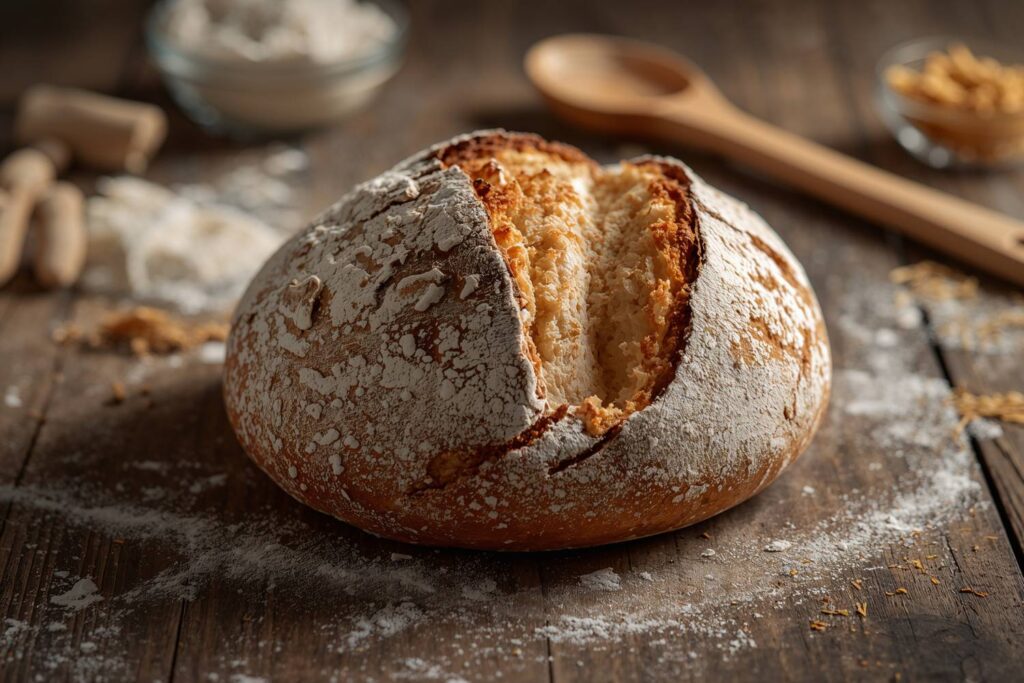Introduction
Rustic Sourdough Bread is a classic artisan loaf with a chewy crust, airy crumb, and the distinctive tang that only sourdough provides. Unlike commercial breads, sourdough is made with a natural starter—just flour, water, and wild yeast—resulting in a flavorful and wholesome loaf.
This bread is beloved for its simplicity and tradition. It’s the kind of bread that feels both ancient and timeless, baked in hearths for centuries and still treasured today. Its rugged appearance and hearty texture make it a centerpiece on any table.
Why I Love This Recipe
I love this recipe because it combines both art and science. Each loaf feels alive and unique, shaped by the wild yeast and fermentation process. The satisfaction of creating bread from just flour, water, and salt is unmatched—it feels like magic.
The flavor is incredible too: tangy, nutty, and deeply satisfying. Toasted with butter, dipped into soup, or served alongside cheese, every slice feels special.
Why This is a Must-Try Dish
- Nutrient-rich & wholesome: Naturally fermented for easier digestion and better nutrition.
- Incredible flavor: Deep, tangy notes you can’t find in store-bought bread.
- Beautiful texture: Crisp crust with a soft, airy crumb.
- Traditional craft: Baking sourdough is both rewarding and therapeutic.
Recipe Information
- Preparation Time: 30 minutes (active)
- Fermentation & Proofing: 12–18 hours (mostly hands-off)
- Cooking Time: 40–45 minutes
- Total Time: About 14–20 hours (depending on proofing)
- Servings: 1 large loaf (10–12 slices)
- Calories: ~170 per slice (approximate)
- Cuisine: European / Artisan
- Course: Bread / Side
Ingredients
For the Dough
- 500 g (4 cups) bread flour (or all-purpose flour)
- 375 g (1 ½ cups + 1 tbsp) warm water
- 100 g (½ cup) active sourdough starter (fed and bubbly)
- 10 g (2 tsp) salt
Simple Cooking Directions
- Mix starter, water, and flour. Rest (autolyse).
- Add salt and fold dough.
- Bulk ferment with stretch-and-folds.
- Shape dough and proof overnight.
- Bake in a preheated Dutch oven until golden and crusty.
Step-by-Step Preparation
Step 1: Mix and Autolyse
- In a large bowl, mix flour, starter, and water until combined.
- Cover and let rest 30–45 minutes (this develops gluten).
Step 2: Add Salt
- Sprinkle salt over the dough.
- Gently knead or pinch the dough until incorporated.
Step 3: Bulk Fermentation
- Cover dough and let rise at room temperature (4–6 hours).
- Every 30 minutes during the first 2 hours, perform stretch-and-folds: grab the edge of dough, stretch up, fold over. Rotate bowl and repeat 4 times.
Step 4: Pre-Shape and Bench Rest
- After bulk fermentation, gently turn dough onto a floured surface.
- Pre-shape into a round ball, cover, and let rest 20 minutes.
Step 5: Final Shape and Proof
- Shape into a tight round or oval loaf.
- Place seam-side up in a floured proofing basket (or bowl with towel).
- Cover and refrigerate 8–12 hours (overnight cold proof).
Step 6: Bake
- Preheat oven to 475°F (245°C) with a Dutch oven inside.
- Turn dough onto parchment paper, seam-side down.
- Score the top with a sharp knife or razor.
- Place dough into the Dutch oven, cover, and bake 20 minutes.
- Remove lid and bake another 20–25 minutes until golden brown.
- Cool on a wire rack at least 1 hour before slicing.
How to Serve
- Slice warm with butter, jam, or honey.
- Perfect alongside soups, stews, and salads.
- Makes incredible sandwiches and toast.
- Serve with cheese boards for a rustic touch.
Additional Recipe Tips
- Use an active, bubbly starter for best results.
- Longer fermentation = better flavor and texture.
- A Dutch oven creates steam for a crisp crust, but if you don’t have one, bake on a baking stone with a tray of hot water in the oven.
- Always let bread cool before slicing—cutting too early can make it gummy.
Variations
- Whole Wheat Sourdough: Replace up to 50% of flour with whole wheat.
- Seeded Sourdough: Add sesame, sunflower, or flax seeds during folding.
- Herb Sourdough: Mix in rosemary, thyme, or garlic.
- Olive & Cheese Sourdough: Fold in olives and shredded cheese before shaping.
Freezing & Storage
- Storage: Keep at room temperature in a paper bag or wrapped in a towel for 2–3 days.
- Freezing: Slice, wrap in foil or plastic, and freeze up to 2 months. Reheat in the oven or toaster.
- Avoid plastic bags: They make the crust soft (unless that’s preferred).
Special Equipment Needed
- Mixing bowl
- Dough scraper
- Proofing basket (banneton) or lined bowl
- Dutch oven (preferred for baking)
- Parchment paper
- Bread lame or sharp knife (for scoring)
Conclusion
Rustic Sourdough Bread is more than just bread—it’s a craft, a tradition, and a deeply rewarding experience. With its crisp crust, chewy crumb, and tangy flavor, it’s the perfect loaf for any occasion. Whether you’re enjoying it fresh from the oven or toasted the next day, each slice delivers comfort and flavor that only homemade sourdough can provide.

Rustic Sourdough Bread
Description
Rustic Sourdough Bread is a classic artisan loaf with a chewy crust, airy crumb, and the distinctive tang that only sourdough provides. Unlike commercial breads, sourdough is made with a natural starter—just flour, water, and wild yeast—resulting in a flavorful and wholesome loaf.
Ingredients
Instructions
-
Step 1: Mix and Autolyse : In a large bowl, mix flour, starter, and water until combined. Cover and let rest 30–45 minutes (this develops gluten).
-
Step 2: Add Salt : Sprinkle salt over the dough. Gently knead or pinch the dough until incorporated.
-
Step 3: Bulk Fermentation : Cover dough and let rise at room temperature (4–6 hours). Every 30 minutes during the first 2 hours, perform stretch-and-folds: grab the edge of dough, stretch up, fold over. Rotate bowl and repeat 4 times.
-
Step 4: Pre-Shape and Bench Rest : After bulk fermentation, gently turn dough onto a floured surface. Pre-shape into a round ball, cover, and let rest 20 minutes.
-
Step 5: Final Shape and Proof : Shape into a tight round or oval loaf. Place seam-side up in a floured proofing basket (or bowl with towel). Cover and refrigerate 8–12 hours (overnight cold proof).
-
Step 6: Bake :Preheat oven to 475°F (245°C) with a Dutch oven inside. Turn dough onto parchment paper, seam-side down. Score the top with a sharp knife or razor. Place dough into the Dutch oven, cover, and bake 20 minutes. Remove lid and bake another 20–25 minutes until golden brown. Cool on a wire rack at least 1 hour before slicing.



